Joel Hestness
Straight to Zero: Why Linearly Decaying the Learning Rate to Zero Works Best for LLMs
Feb 21, 2025Abstract:LLMs are commonly trained with a learning rate (LR) warmup, followed by cosine decay to 10% of the maximum (10x decay). In a large-scale empirical study, we show that under an optimal peak LR, a simple linear decay-to-zero (D2Z) schedule consistently outperforms other schedules when training at compute-optimal dataset sizes. D2Z is superior across a range of model sizes, batch sizes, datasets, and vocabularies. Benefits increase as dataset size increases. Leveraging a novel interpretation of AdamW as an exponential moving average of weight updates, we show how linear D2Z optimally balances the demands of early training (moving away from initial conditions) and late training (averaging over more updates in order to mitigate gradient noise). In experiments, a 610M-parameter model trained for 80 tokens-per-parameter (TPP) using D2Z achieves lower loss than when trained for 200 TPP using 10x decay, corresponding to an astonishing 60% compute savings. Models such as Llama2-7B, trained for 286 TPP with 10x decay, could likely have saved a majority of compute by training with D2Z.
Crystal: Illuminating LLM Abilities on Language and Code
Nov 06, 2024
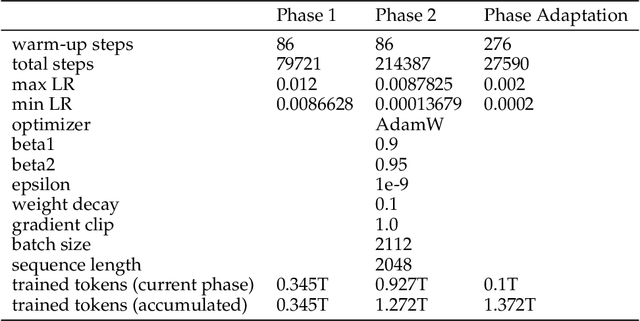
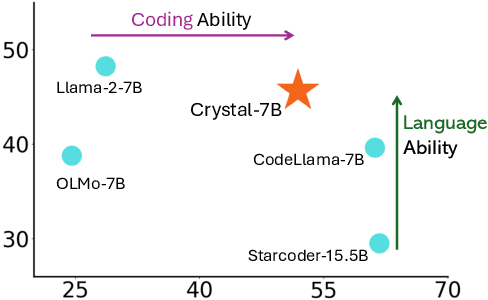
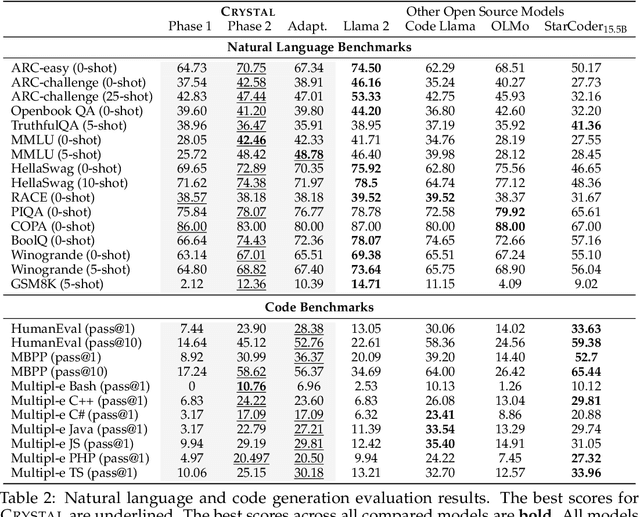
Abstract:Large Language Models (LLMs) specializing in code generation (which are also often referred to as code LLMs), e.g., StarCoder and Code Llama, play increasingly critical roles in various software development scenarios. It is also crucial for code LLMs to possess both code generation and natural language abilities for many specific applications, such as code snippet retrieval using natural language or code explanations. The intricate interaction between acquiring language and coding skills complicates the development of strong code LLMs. Furthermore, there is a lack of thorough prior studies on the LLM pretraining strategy that mixes code and natural language. In this work, we propose a pretraining strategy to enhance the integration of natural language and coding capabilities within a single LLM. Specifically, it includes two phases of training with appropriately adjusted code/language ratios. The resulting model, Crystal, demonstrates remarkable capabilities in both domains. Specifically, it has natural language and coding performance comparable to that of Llama 2 and Code Llama, respectively. Crystal exhibits better data efficiency, using 1.4 trillion tokens compared to the more than 2 trillion tokens used by Llama 2 and Code Llama. We verify our pretraining strategy by analyzing the training process and observe consistent improvements in most benchmarks. We also adopted a typical application adaptation phase with a code-centric data mixture, only to find that it did not lead to enhanced performance or training efficiency, underlining the importance of a carefully designed data recipe. To foster research within the community, we commit to open-sourcing every detail of the pretraining, including our training datasets, code, loggings and 136 checkpoints throughout the training.
Normalization Layer Per-Example Gradients are Sufficient to Predict Gradient Noise Scale in Transformers
Nov 01, 2024Abstract:Per-example gradient norms are a vital ingredient for estimating gradient noise scale (GNS) with minimal variance. Observing the tensor contractions required to compute them, we propose a method with minimal FLOPs in 3D or greater tensor regimes by simultaneously computing the norms while computing the parameter gradients. Using this method we are able to observe the GNS of different layers at higher accuracy than previously possible. We find that the total GNS of contemporary transformer models is predicted well by the GNS of only the normalization layers. As a result, focusing only on the normalization layer, we develop a custom kernel to compute the per-example gradient norms while performing the LayerNorm backward pass with zero throughput overhead. Tracking GNS on only those layers, we are able to guide a practical batch size schedule that reduces training time by 18% on a Chinchilla-optimal language model.
Bilingual Adaptation of Monolingual Foundation Models
Jul 13, 2024



Abstract:We present an efficient method for adapting a monolingual Large Language Model (LLM) to another language, addressing challenges of catastrophic forgetting and tokenizer limitations. We focus this study on adapting Llama 2 to Arabic. Our two-stage approach begins with expanding the vocabulary and training only the embeddings matrix, followed by full model continual pretraining on a bilingual corpus. By continually pretraining on a mix of Arabic and English corpora, the model retains its proficiency in English while acquiring capabilities in Arabic. Our approach results in significant improvements in Arabic and slight enhancements in English, demonstrating cost-effective cross-lingual transfer. We also perform extensive ablations on embedding initialization techniques, data mix ratios, and learning rates and release a detailed training recipe.
Sparse maximal update parameterization: A holistic approach to sparse training dynamics
May 24, 2024Abstract:Several challenges make it difficult for sparse neural networks to compete with dense models. First, setting a large fraction of weights to zero impairs forward and gradient signal propagation. Second, sparse studies often need to test multiple sparsity levels, while also introducing new hyperparameters (HPs), leading to prohibitive tuning costs. Indeed, the standard practice is to re-use the learning HPs originally crafted for dense models. Unfortunately, we show sparse and dense networks do not share the same optimal HPs. Without stable dynamics and effective training recipes, it is costly to test sparsity at scale, which is key to surpassing dense networks and making the business case for sparsity acceleration in hardware. A holistic approach is needed to tackle these challenges and we propose S$\mu$Par as one such approach. S$\mu$Par ensures activations, gradients, and weight updates all scale independently of sparsity level. Further, by reparameterizing the HPs, S$\mu$Par enables the same HP values to be optimal as we vary both sparsity level and model width. HPs can be tuned on small dense networks and transferred to large sparse models, greatly reducing tuning costs. On large-scale language modeling, S$\mu$Par training improves loss by up to 8.2% over the common approach of using the dense model standard parameterization.
MediSwift: Efficient Sparse Pre-trained Biomedical Language Models
Mar 01, 2024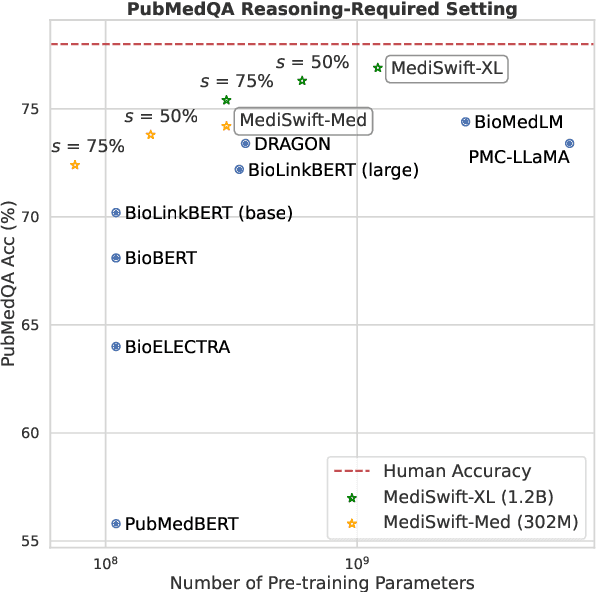
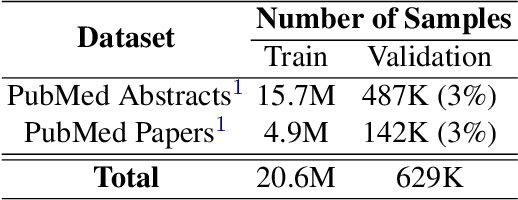
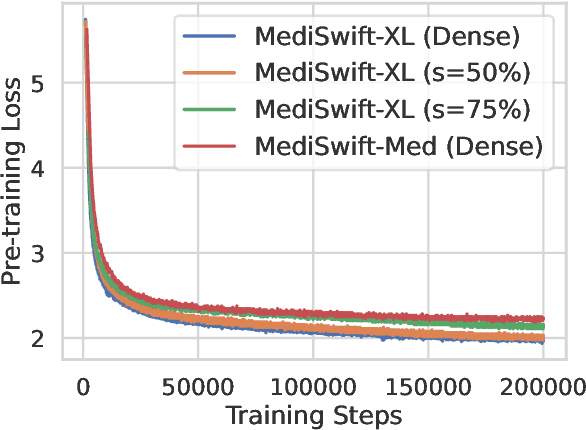
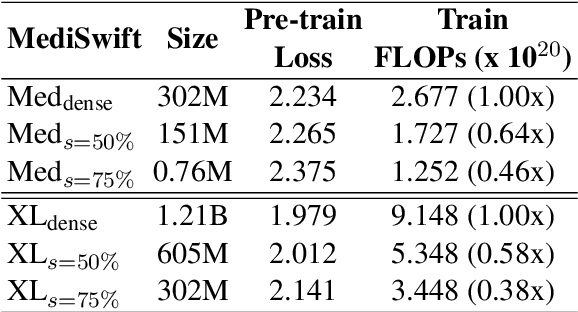
Abstract:Large language models (LLMs) are typically trained on general source data for various domains, but a recent surge in domain-specific LLMs has shown their potential to outperform general-purpose models in domain-specific tasks (e.g., biomedicine). Although domain-specific pre-training enhances efficiency and leads to smaller models, the computational costs of training these LLMs remain high, posing budgeting challenges. We introduce MediSwift, a suite of biomedical LMs that leverage sparse pre-training on domain-specific biomedical text data. By inducing up to 75% weight sparsity during the pre-training phase, MediSwift achieves a 2-2.5x reduction in training FLOPs. Notably, all sparse pre-training was performed on the Cerebras CS-2 system, which is specifically designed to realize the acceleration benefits from unstructured weight sparsity, thereby significantly enhancing the efficiency of the MediSwift models. Through subsequent dense fine-tuning and strategic soft prompting, MediSwift models outperform existing LLMs up to 7B parameters on biomedical tasks, setting new benchmarks w.r.t efficiency-accuracy on tasks such as PubMedQA. Our results show that sparse pre-training, along with dense fine-tuning and soft prompting, offers an effective method for creating high-performing, computationally efficient models in specialized domains.
Position Interpolation Improves ALiBi Extrapolation
Oct 18, 2023Abstract:Linear position interpolation helps pre-trained models using rotary position embeddings (RoPE) to extrapolate to longer sequence lengths. We propose using linear position interpolation to extend the extrapolation range of models using Attention with Linear Biases (ALiBi). We find position interpolation significantly improves extrapolation capability on upstream language modelling and downstream summarization and retrieval tasks.
BTLM-3B-8K: 7B Parameter Performance in a 3B Parameter Model
Sep 20, 2023



Abstract:We introduce the Bittensor Language Model, called "BTLM-3B-8K", a new state-of-the-art 3 billion parameter open-source language model. BTLM-3B-8K was trained on 627B tokens from the SlimPajama dataset with a mixture of 2,048 and 8,192 context lengths. BTLM-3B-8K outperforms all existing 3B parameter models by 2-5.5% across downstream tasks. BTLM-3B-8K is even competitive with some 7B parameter models. Additionally, BTLM-3B-8K provides excellent long context performance, outperforming MPT-7B-8K and XGen-7B-8K on tasks up to 8,192 context length. We trained the model on a cleaned and deduplicated SlimPajama dataset; aggressively tuned the \textmu P hyperparameters and schedule; used ALiBi position embeddings; and adopted the SwiGLU nonlinearity. On Hugging Face, the most popular models have 7B parameters, indicating that users prefer the quality-size ratio of 7B models. Compacting the 7B parameter model to one with 3B parameters, with little performance impact, is an important milestone. BTLM-3B-8K needs only 3GB of memory with 4-bit precision and takes 2.5x less inference compute than 7B models, helping to open up access to a powerful language model on mobile and edge devices. BTLM-3B-8K is available under an Apache 2.0 license on Hugging Face: https://huggingface.co/cerebras/btlm-3b-8k-base.
SlimPajama-DC: Understanding Data Combinations for LLM Training
Sep 19, 2023



Abstract:This paper aims to understand the impacts of various data combinations (e.g., web text, wikipedia, github, books) on the training of large language models using SlimPajama. SlimPajama is a rigorously deduplicated, multi-source dataset, which has been refined and further deduplicated to 627B tokens from the extensive 1.2T tokens RedPajama dataset contributed by Together. We've termed our research as SlimPajama-DC, an empirical analysis designed to uncover fundamental characteristics and best practices associated with employing SlimPajama in the training of large language models. During our research with SlimPajama, two pivotal observations emerged: (1) Global deduplication vs. local deduplication. We analyze and discuss how global (across different sources of datasets) and local (within the single source of dataset) deduplications affect the performance of trained models. (2) Proportions of high-quality/highly-deduplicated multi-source datasets in the combination. To study this, we construct six configurations of SlimPajama dataset and train individual ones using 1.3B Cerebras-GPT model with Alibi and SwiGLU. Our best configuration outperforms the 1.3B model trained on RedPajama using the same number of training tokens by a significant margin. All our 1.3B models are trained on Cerebras 16$\times$ CS-2 cluster with a total of 80 PFLOP/s in bf16 mixed precision. We further extend our discoveries (such as increasing data diversity is crucial after global deduplication) on a 7B model with large batch-size training. Our models and the separate SlimPajama-DC datasets are available at: https://huggingface.co/MBZUAI-LLM and https://huggingface.co/datasets/cerebras/SlimPajama-627B.
Cerebras-GPT: Open Compute-Optimal Language Models Trained on the Cerebras Wafer-Scale Cluster
Apr 06, 2023Abstract:We study recent research advances that improve large language models through efficient pre-training and scaling, and open datasets and tools. We combine these advances to introduce Cerebras-GPT, a family of open compute-optimal language models scaled from 111M to 13B parameters. We train Cerebras-GPT models on the Eleuther Pile dataset following DeepMind Chinchilla scaling rules for efficient pre-training (highest accuracy for a given compute budget). We characterize the predictable power-law scaling and compare Cerebras-GPT with other publicly-available models to show all Cerebras-GPT models have state-of-the-art training efficiency on both pre-training and downstream objectives. We describe our learnings including how Maximal Update Parameterization ($\mu$P) can further improve large model scaling, improving accuracy and hyperparameter predictability at scale. We release our pre-trained models and code, making this paper the first open and reproducible work comparing compute-optimal model scaling to models trained on fixed dataset sizes. Cerebras-GPT models are available on HuggingFace: https://huggingface.co/cerebras.
 Add to Chrome
Add to Chrome Add to Firefox
Add to Firefox Add to Edge
Add to Edge